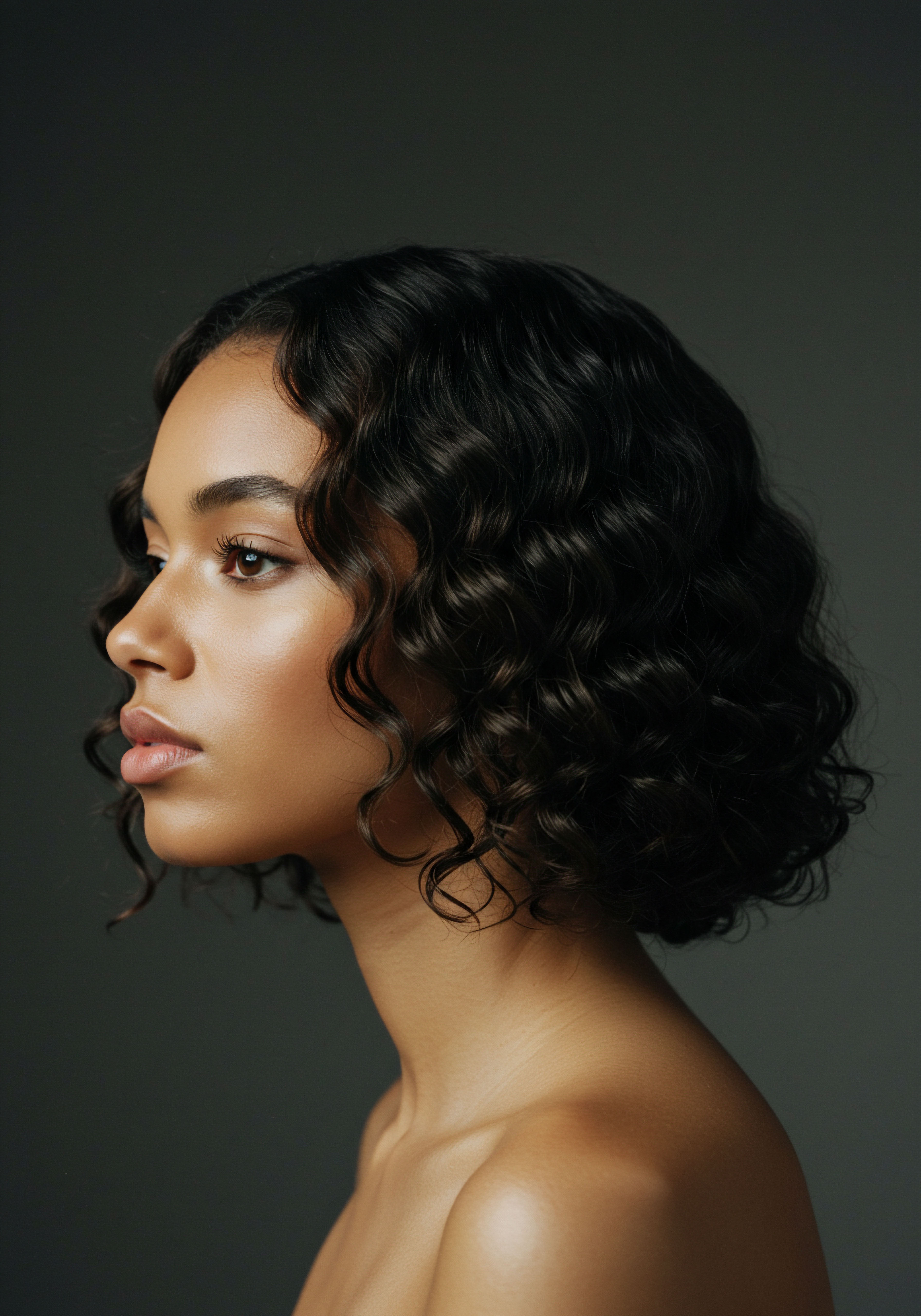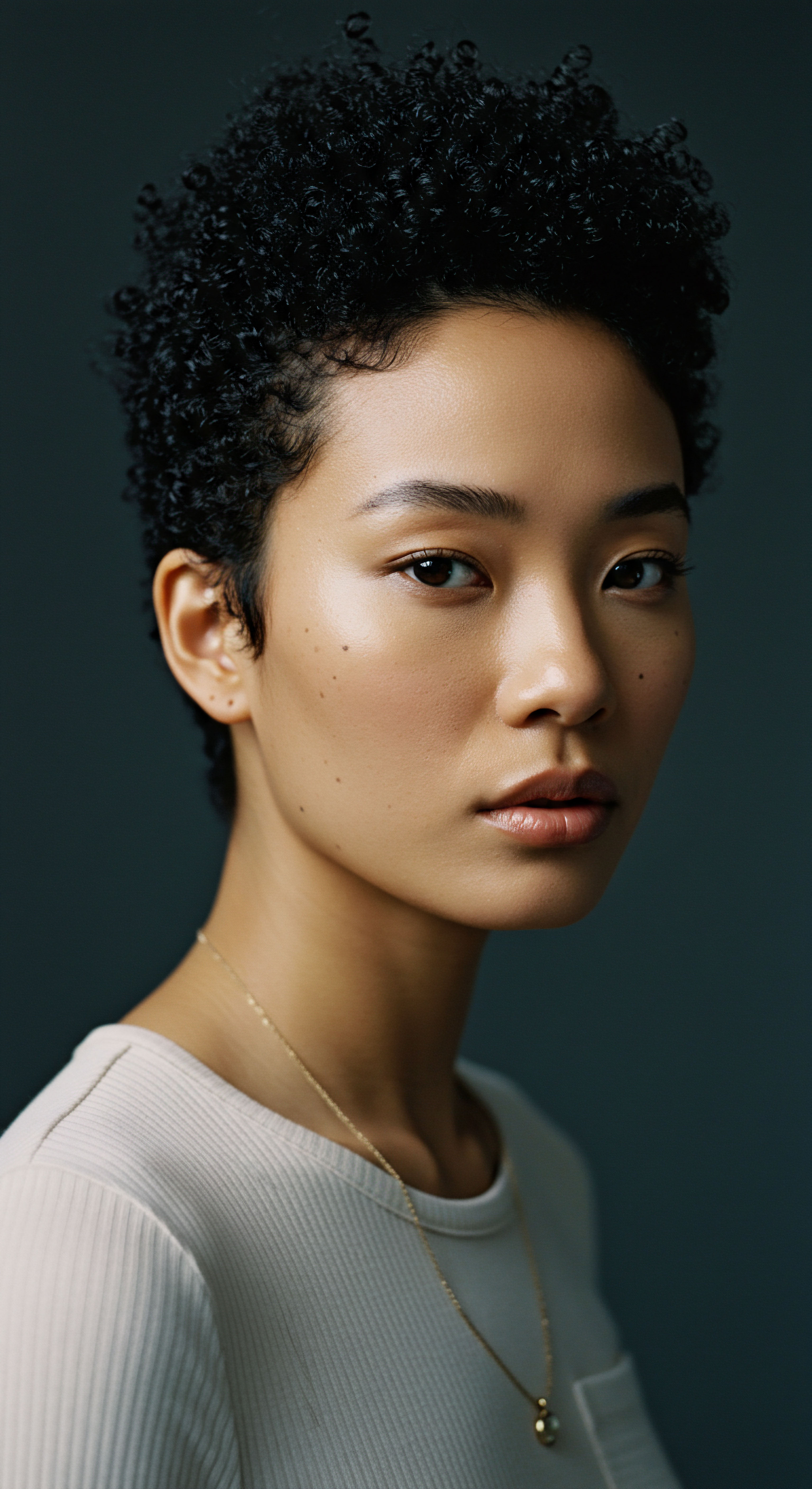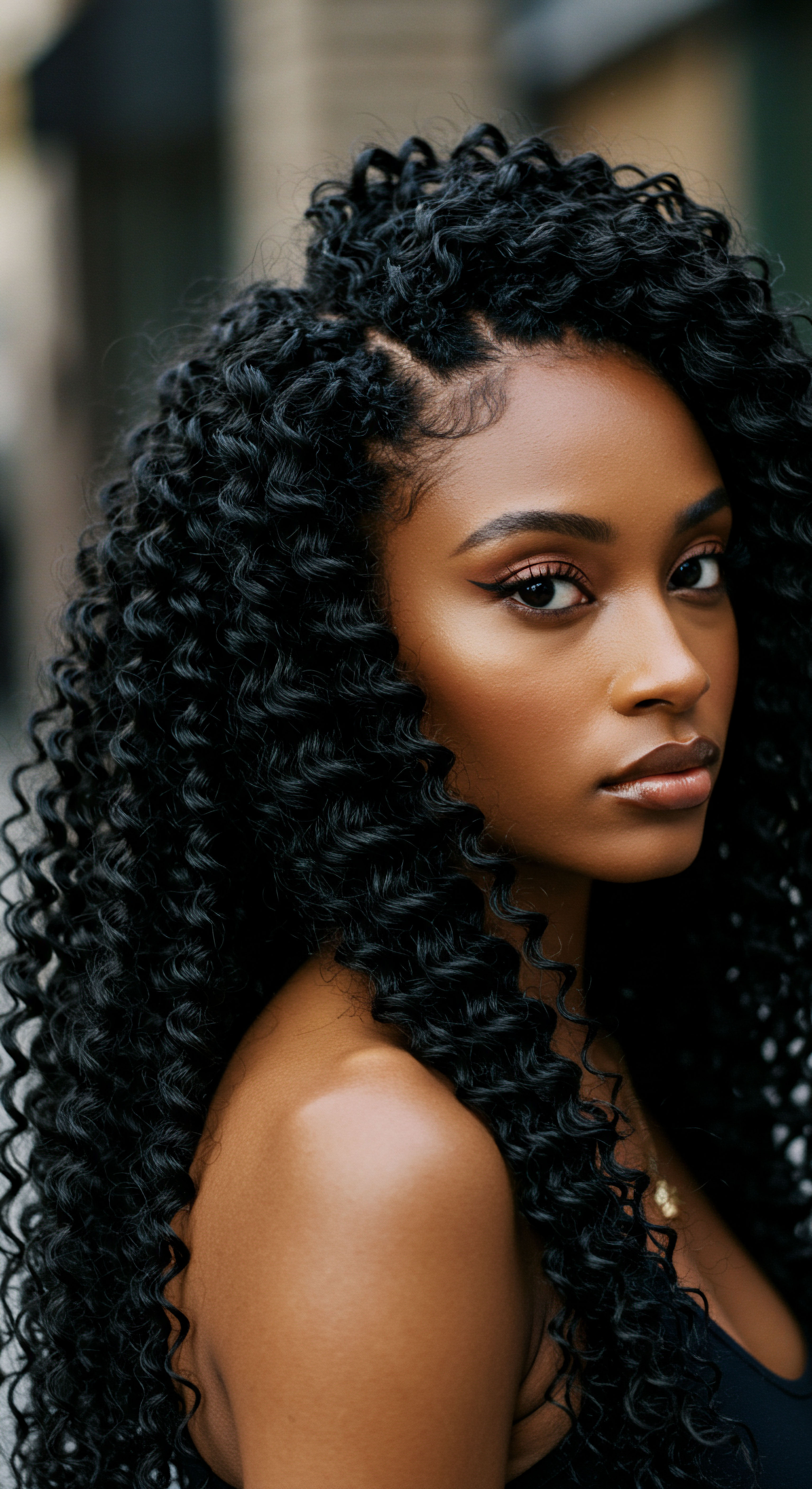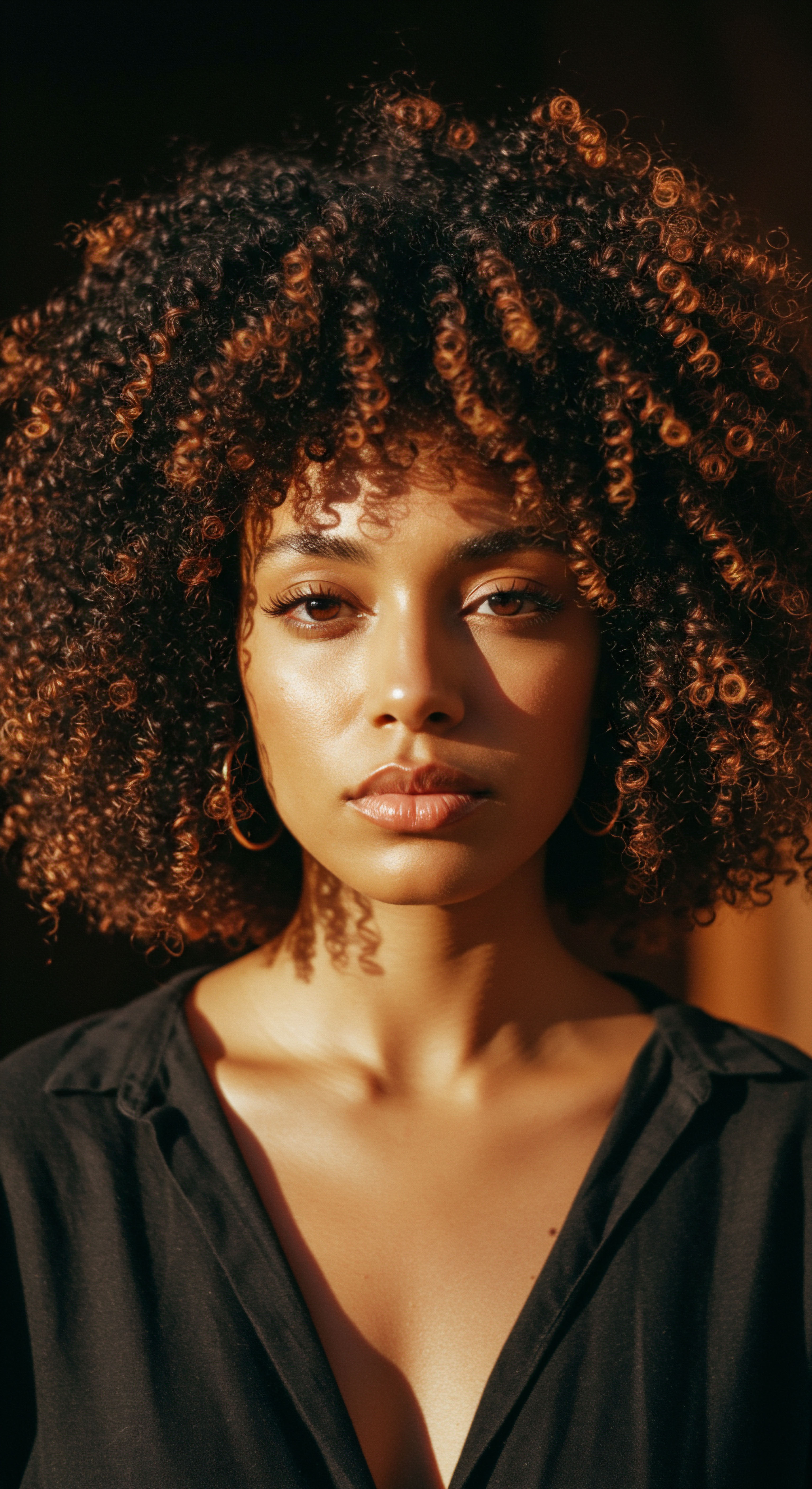
Roots
A quiet ripple often begins long before it reaches the surface, and so it is with our understanding of water and its silent presence in the life of textured strands. We often hold our hair in our hands, feeling its texture, admiring its form, yet rarely do we pause to consider the invisible currents that shape its very being, from the earth’s deep aquifers to the soft cascade from our showerheads. The story of textured hair, from ancient traditions to modern routines, is inextricably linked to water.
It is a connection both elemental and profound, holding secrets about how our daily choices might extend their influence far beyond our bathrooms, touching the planet’s most precious resource. This exploration begins by acknowledging water’s fundamental role, not just as a cleansing agent, but as a participant in the very structure and cultural significance of hair.

Water’s Essential Dance with Hair
Hair, particularly textured hair with its unique coiled and curled architecture, possesses a complex relationship with water. Each strand, composed of keratin proteins, is a marvel of biological engineering. While hair itself is naturally hydrophobic, meaning it repels water to maintain its internal structure, water plays a critical external role in its health and malleability.
It acts as a vehicle for cleansing agents, allowing dirt and product buildup to be lifted away. Beyond that, water facilitates the application of conditioning treatments, helping them spread evenly and temporarily swell the hair cuticle, permitting beneficial ingredients to settle.
The quality of water we use can also play a quiet, yet significant, part. Hard water, laden with minerals like calcium and magnesium, can deposit a subtle film on hair, leading to a dull appearance or a sense of dryness. This mineral accumulation can hinder the effectiveness of products, making it seem as though more product or more rinsing is needed, thereby increasing water use.
Conversely, soft water, with fewer dissolved minerals, allows products to lather more freely and rinse away cleanly, promoting a feeling of softness and shine. Understanding these interactions forms a foundational step in considering our product choices.

Cultural Water Wisdom
Across generations and diverse cultures, water has held a sacred standing in hair rituals. From ancient African practices where natural springs provided cleansing and blessing, to indigenous communities who respected rivers as life-giving arteries for both body and spirit, the act of hair care was often interwoven with a deep reverence for water. These traditions frequently emphasized efficiency and thoughtful use, not out of scarcity, but out of an innate appreciation for water’s vital force. The practice of using natural clays or minimal, potent botanical extracts for cleansing and conditioning often required less rinsing, inherently conserving water.
Consider the ancestral wisdom embedded in co-washing practices, where hair is cleansed primarily with conditioner. This method, long adopted by many with textured hair, inherently reduces the need for extensive lathering and subsequent rinsing associated with traditional shampoos. It speaks to an intuitive understanding of hair’s needs and water’s properties, often passed down through family lines, offering a gentle approach that aligns with water-conscious principles. This historical perspective grounds our present discussion, reminding us that conscious water use in hair care is not a new concept, but a return to thoughtful, time-honored ways.
Water’s quiet presence in the life of textured hair extends from its fundamental role in hair structure to its deep cultural significance in care traditions.

Hair’s Thirst and Environmental Currents
The environmental water footprint of hair care stretches beyond the water we personally use. It extends into the invisible, or ‘virtual,’ water consumed during the manufacturing of products, the cultivation of ingredients, and the energy needed for heating and cooling processes within factories. This larger context highlights that our choices have a reach far beyond our immediate personal routines.
To grasp the scope, consider that the beauty industry as a whole utilized approximately 10.4 Million Tons of Water globally in 2020. This figure encompasses water used in product formulation, ingredient sourcing, and manufacturing. Hair care, specifically the bath and shower categories, account for a significant portion of this industrial water consumption. When a single bottle of shampoo can require up to 22 Liters of Water for its production, the cumulative impact of consumer choices becomes evident.
The challenge before us is to align the personal need for hair health with the planet’s finite resources. It invites us to consider how our choices, from the ingredients in our cleansers to the consistency of our conditioners, can quietly contribute to a more mindful relationship with water, both in our homes and across the global supply chain.

Ritual
Stepping from the foundational currents of water’s presence into the tangible rhythms of our daily care, we find ourselves in the realm of ritual. Here, the intimate acts of washing, conditioning, and styling our textured hair become a point of connection between personal well-being and wider environmental considerations. The choices we make on our bathroom shelves and during our routines hold practical weight, influencing not only the health of our coils and curls but also the flow of water that sustains us all. This section seeks to illuminate how intentional selections can lead to a more water-wise approach in our hair care practices.

Product Formulation and Water Footprint
Many hair care products, particularly rinse-off formulations such as shampoos and conditioners, contain a substantial amount of water. It is not uncommon for these liquid products to be composed of up to 95% Water. This high water content means that a significant portion of the product’s volume, and therefore its associated environmental footprint, is tied to this single ingredient. The journey of this water begins long before it reaches our homes, encompassing extraction, purification, and transportation, each step bearing its own environmental cost.
Conversely, the emergence of concentrated or ‘waterless’ beauty products offers a different path. Solid shampoo bars, conditioner bars, and highly concentrated serums represent a shift towards formulations that either contain minimal water or none at all. By removing water from the product itself, these innovations reduce the product’s weight and volume, leading to decreased energy consumption and associated emissions during shipping. They also diminish the need for extensive packaging, as a smaller, denser product can often be housed in more compact or recyclable materials.

Water-Wise Cleansing Routines
The act of washing textured hair often involves multiple rinsing steps to ensure products are thoroughly removed, which can consume a considerable amount of water. However, small adjustments to our routine can yield noticeable savings.
- Co-Washing ❉ This practice, where hair is cleansed primarily with conditioner, often requires less water than a full shampoo and rinse cycle, as conditioners are typically easier to distribute and rinse from textured strands.
- Concentrated Products ❉ Opting for shampoos and conditioners that are highly concentrated means less product is needed per wash, leading to fewer overall rinses and less water flowing down the drain.
- Showerhead Efficiency ❉ Installing a low-flow showerhead can significantly reduce water consumption during washing without compromising the effectiveness of the rinse.
Consider the impact of water temperature as well. While hot water can feel comforting, it also contributes to the energy consumption required for heating, and it can strip natural oils from the hair, sometimes prompting the use of more conditioning products and, by extension, more rinse water. Lukewarm water is often sufficient for effective cleansing and can be gentler on both hair and the environment.

Beyond the Bottle ❉ Product Choices and Rinse Impact
The ingredients within our hair care products also play a part in their environmental water impact. Certain chemicals, such as sulfates and parabens, commonly found in conventional shampoos and conditioners, can become water pollutants once they are washed down the drain. These substances can disrupt aquatic ecosystems and affect marine life.
Choosing products with biodegradable ingredients or those derived from sustainable sources helps lessen the burden on water treatment systems and reduces the potential for environmental contamination. When product residues are less harmful, the water returned to the environment is cleaner, supporting healthier waterways.
Intentional product choices, from concentrated formulas to biodegradable ingredients, directly shape the water footprint of our hair care rituals.
| Practice Co-Washing |
| Water Saving Mechanism Reduces need for extensive shampoo rinsing. |
| Benefit for Textured Hair Preserves natural oils, promotes moisture retention. |
| Practice Waterless Formulations |
| Water Saving Mechanism Less water in product manufacturing and transport. |
| Benefit for Textured Hair Often highly concentrated, requiring less product. |
| Practice Efficient Rinsing |
| Water Saving Mechanism Minimizes time under running water. |
| Benefit for Textured Hair Prevents product buildup, maintains hair health. |
| Practice Cooler Water Use |
| Water Saving Mechanism Reduces energy for water heating. |
| Benefit for Textured Hair Helps close hair cuticles, enhancing shine. |
| Practice Adopting these practices contributes to both environmental water conservation and hair well-being. |
The ripple effect of our daily hair care rituals is considerable. By selecting products thoughtfully and adjusting our application methods, we contribute to a broader movement of water conservation. It is a gentle yet powerful shift, one that honors both our hair and the planet’s precious water cycles.

Relay
As our contemplation deepens, moving beyond the immediate sphere of personal ritual, we encounter the vast, interconnected currents of the global water system and the beauty industry’s place within it. The question of whether product choices for textured hair genuinely lessen environmental water impact stretches into realms of manufacturing, supply chains, and consumer consciousness on a collective scale. This section invites a more intricate understanding, where scientific data meets societal patterns, revealing the profound interplay between our individual decisions and the planet’s delicate balance.

Water Scarcity and the Global Beauty Industry
Water scarcity is a growing global concern, impacting billions of people and ecosystems worldwide. The beauty industry, as a significant consumer of water, finds itself at a critical juncture. Beyond the water used in product formulations, considerable volumes are consumed in the cultivation of raw materials, such as water-intensive botanical extracts, and throughout manufacturing processes for cleaning, cooling, and ingredient processing.
A study by the Carbon Trust revealed that a substantial portion of the beauty industry’s emissions, approximately 59%, originates from consumers washing products with hot water heated by fossil fuels. While this statistic speaks to carbon emissions, it powerfully underscores the sheer volume of water, and the energy to heat it, that flows through our homes during hair care. This ‘use phase’ is often the largest contributor to the environmental footprint of rinse-off products like shampoos and conditioners, overshadowing even the production and packaging stages. This suggests that consumer behavior holds immense sway over the overall water burden.

Ingredient Sourcing and Water’s Hidden Costs
The choice of ingredients in textured hair products carries a ‘hidden’ water cost, often referred to as ‘virtual water.’ This accounts for the water consumed in the entire supply chain of a raw material, from its agricultural cultivation to its processing into a cosmetic ingredient. For example, certain plant-derived ingredients, while seemingly natural, may come from regions experiencing water stress or require extensive irrigation.
The shift towards more sustainable ingredient sourcing, such as ingredients derived from biotechnology that require less water to produce, or those from regenerative agriculture practices, offers a path to lessening this virtual water footprint. When brands commit to transparency regarding their supply chains, consumers gain the capacity to make more informed choices that align with water conservation principles.

Can Consumer Behavior Truly Shift Water Use?
The idea that individual consumer choices can alter large-scale environmental impact sometimes meets skepticism. However, collective action, even through seemingly small adjustments, holds considerable power. For instance, removing a single rinsing step from a hair washing routine can conserve between 30% to 50% of Water used during that wash. When millions of individuals adopt such practices, the cumulative savings become substantial.
The rise of waterless beauty products, such as solid bars or concentrated formulas, represents a direct response to this challenge. These products not only lessen the water content within the product itself but also often encourage less water usage during the application and rinsing phases. This aligns with a growing consumer desire, with over 44% of Consumers stating their aim to use less water for a positive environmental impact.
Education plays a quiet but significant role here. Understanding that a product designed for quick rinsing, or a solid bar that lathers easily, can genuinely lessen water use in the shower empowers consumers to become active participants in water conservation.

Circularity in Hair Care and Water Stewardship
Beyond individual product choices, the broader industry is exploring circular economy principles to reduce water impact. This involves designing products and packaging for reuse, refill, and recycling, thereby lessening the demand for virgin resources and the water needed to process them.
- Refill Systems ❉ Brands offering refill pouches or stations for liquid products significantly reduce the need for new plastic bottle production, saving the water associated with manufacturing new packaging.
- Water Reuse in Manufacturing ❉ Factories are implementing advanced water treatment and recycling systems to reuse water within their production cycles, lessening their draw from local freshwater sources.
- Product End-Of-Life ❉ Designing products with biodegradable ingredients means that when they are rinsed down the drain, they break down more readily, reducing the burden on wastewater treatment plants and lessening potential aquatic contamination.
The concept of water stewardship extends to corporate responsibility, where companies are setting ambitious targets to reduce their water consumption across operations. For example, major personal care companies have committed to reducing water consumption per finished product by significant percentages over the coming years. This collective industry movement, coupled with informed consumer choices, creates a powerful relay of action towards a more water-conscious future for textured hair care.
The greatest water impact in hair care often stems from consumer use, underscoring the collective power of thoughtful routines and product selections.
| Lifecycle Stage Ingredient Sourcing |
| Primary Water Consumption Cultivation of water-intensive plants. |
| Mitigation Strategy Sustainable agriculture, biotech ingredients. |
| Lifecycle Stage Manufacturing |
| Primary Water Consumption Production processes, cleaning, cooling. |
| Mitigation Strategy Water recycling, closed-loop systems. |
| Lifecycle Stage Packaging Production |
| Primary Water Consumption Water used in plastic or glass manufacturing. |
| Mitigation Strategy Recycled content, lightweight designs, refills. |
| Lifecycle Stage Consumer Use |
| Primary Water Consumption Washing, rinsing, hot water heating. |
| Mitigation Strategy Waterless products, efficient rinsing, cooler water. |
| Lifecycle Stage Disposal |
| Primary Water Consumption Pollution from non-biodegradable ingredients. |
| Mitigation Strategy Biodegradable formulations, proper waste management. |
| Lifecycle Stage Addressing water impact requires action at every stage of a product's existence. |

Reflection
The conversation surrounding product choices for textured hair and their environmental water impact is not a simple one, nor is it a journey with a singular destination. It is a winding path, illuminated by the quiet wisdom of ancient practices and the sharp clarity of scientific inquiry. We find ourselves at a moment where personal care intertwines with planetary care, where the beauty we seek for our strands can mirror the health we wish for our world. The textured hair community, with its deep connection to natural forms and its history of resourceful care, stands uniquely positioned to lead this quiet revolution.
Each thoughtful choice, each gentle rinse, each consideration of a product’s journey, contributes to a larger symphony of change. The task before us is not to achieve perfection, but to move with intention, recognizing that every drop counts, every ingredient tells a story, and every ritual holds the promise of a more balanced relationship with the living waters of our Earth.

References
- CleanHub. (2024). What is the Environmental Impact of the Beauty Industry? CleanHub’s Blog.
- NATRUE. (2020). Water in cosmetics ❉ a dive into water-free beauty.
- Hairstory. (2023). Shampoo Pollution ❉ How Does Shampoo Pollute The Water?
- Natural Colour Works. (2023). The Environmental Impact Of Organic Hair Care.
- Ellatu. (2024). Understanding the Environmental Impact of Hair Care Products.
- Lebubè. (2024). Beauty Industry’s Water Footprint & Sustainable Solutions.
- SOPHIM. (2024). Cosmetics increasingly sensitive to water resource issues.
- Gonçalves, C. & Santos, M. (2022). Water sustainability ❉ A waterless life cycle for cosmetic products. Journal of Cleaner Production, 343, 130847.
- That Solid. (2024). Water Conservation in the Beauty Industry ❉ A Wave of Change.
- Kuehn, C. & Lorscheid, S. (2021). Life Cycle Assessment of a Plant-Based, Regionally Marketed Shampoo and Analysis of Refill Options. Sustainability, 13(19), 10926.
- Cosmetics Europe. (2017). Study into the development of Product Environmental Footprint Category Rules (PEFCR) for Shampoo ❉ Explanatory Document.
- L’Oréal. (2021). Product Environmental & Social Impact Labelling Methodologies.
- Euromonitor International. (2022). Waterless Beauty ❉ Opportunities Beyond Compliance.
- Cosmébio. (2024). Hydrating and Caring for Curly Textured Hair.
- Obé Headwear. (2024). How water affects different hair types.